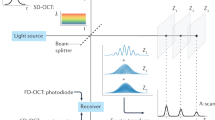Abstract
Introduction
The development of the neuroendoscope has allowed neurosurgeons to visualize anatomic structures deep within the nervous system with minimal disruption of the critical overlying structures. This has enabled the development of an entire system of tools and techniques for maximum effective action at the target point through minimal corridors for the treatment of an entire spectrum of pathologies.
Discussion
The design of an optical instrument with the ability to illuminate deep, hidden anatomic structures and transmit those images accurately and brightly to the eye of the neurosurgeon poses several challenges. These challenges have been met by advances in lens design and optical systems engineering over a period of several decades leading up to emergence of the modern neuroendoscope. In this paper, the basic concepts of the physics of image formation in optical systems are reviewed with emphasis on those elements critical to the endoscope.
Conclusion
A consideration of these basic concepts is critical to the understanding of the limitations and capabilities of the key instrument for neuroendoscopy.





Similar content being viewed by others
References
Apuzzo MLJ, Liu CY (2001) Things to come. Neurosurgery 49:765–778
Apuzzo MLJ, Liu CY (2002) Honored guest presentation: quid novi? In the realm of ideas—the neurosurgical dialectic. Clin Neurosurg 49:159–187
Apuzzo MLJ, Heifetz MD, Weiss MH, Kurze T (1977) Neurosurgical endoscopy using side-viewing telescope—technical note. J Neurosurg 46:398–400
Apuzzo MLJ, Chandrasoma PT, Cohen D, Zee CS, Zelman V (1987) Computed imaging stereotaxy: experience and perspective related to 500 procedures applied to brain masses. Neurosurgery 20:930–937
Apuzzo MLJ, Liu CY, Sullivan D, Faccio RA (2002) Honored guest presentation: surgery of the human cerebrum—a collective modernity. Clin Neurosurg 49:27–89
Berci G (ed) (1976) Endoscopy. Prentice-Hall, New York
Dandy WE (1918) Extirpation of the choroid plexus of the lateral ventricles in communicating hydrocephalus. Ann Surg 68:569–579
Dandy WE (1922) Operative procedure for hydrocephalus. Bull Johns Hopkins Hospital 33:189
Dandy WE (1945) Diagnosis and treatment of strictures of the aqueduct of sylvius (causing hydrocephalus). Arch Surg 51:1–14
Fay T, Grant FC (1923) Ventriculoscopy and intraventricular photography in internal hydrocephalus. J Am Med Assoc 80:461–463
Fischer RE, Biljana T (2000) Optical system design. McGraw Hill, New York
Fukushima T, Ishijima B, Hirakawa K, Nakamura N, Sano K (1973) Ventriculofiberscope: a new technique for endoscopic diagnosis and operation. Technical note. J Neurosurg 38:251–256
Guiot G, Rougerie J, Fourestier M, Fournier A, Comoy C, Vulmiere J, Groux R (1963) Une nouvelle technique endoscopique—explorations endoscopiques intracraniennes. Presse Med 71:1225–1228
Hecht J (1999) City of light: the story of fiber optics. Oxford University Press, New York
Hopkins HH (1966) Optical system having cylindrical rod-like lenses, in US Patent 3257902, USA
Hopkins HH (1976) Optical principles of the endoscope. In: Berci G (ed) Endoscopy. Prentice-Hall, New York, pp 3–27
Jho HD, Carrau RL (1997) Endoscopic endonasal transsphenoidal surgery: experience with 50 patients. J Neurosurg 87:44–51
Laikin M (2001) Method of lens design. Dekker, New York
Leiner DC (2002) Miniature optics in the hospital operating room, www.lighthouseoptics.com/tutorials-leiner.htm
Liu CY, Apuzzo MLJ (2003) The genesis of neurosurgery and the evolution of the neurosurgical operative environment. I. Prehistory to 2003. Neurosurgery 52:3–19
Liu CY, Spicer M, Apuzzo MLJ (2003) The genesis of neurosurgery and the evolution of the neurosurgical operative environment. II. Concepts for future development, 2003 and beyond. Neurosurgery 52:20–33
Olinger CP, Ohlhaber RL (1974) Eighteen-gauge microscopic-telescopic needle endoscope with electrode channel: potential clinical and research application. Surg Neurol 2:151–160
Olinger CP, Ohlhaber RL (1975) Eighteen-gauge needle endoscope with flexible viewing system. Surg Neurol 4:537–538
Prescott R, Leiner DC (1985) Optical system, in US Patent 4515444, Dyonics, USA
Putnum TJ (1934) Treatment of hydrocephalus by endoscopic coagulation of the choroid plexus. N Engl J Med 210:1373–1376
Putnum TJ (1942) The surgical treatment of infantile hydrocephalus. Surg Gynecol Obstet 76:171–182
Scarff JE (1935) Endoscopic treatment of hydrocephalus. Arch Neurol Psychiatry 35:853–861
Smith WJ (2000) Modern optical engineering. McGraw Hill, New York
Spicer MA, Apuzzo MLJ (2003) Virtual reality surgery: neurosurgery and the contemporary landscape. Neurosurgery 52:489–496
Yaniv E, Rappaport ZH (1997) Endoscopic transseptal transsphenoidal surgery for pituitary surgery. Neurosurgery 40:944–946
Author information
Authors and Affiliations
Corresponding author
Rights and permissions
About this article
Cite this article
Liu, C.Y., Wang, M.Y. & Apuzzo, M.L.J. The physics of image formation in the neuroendoscope. Childs Nerv Syst 20, 777–782 (2004). https://doi.org/10.1007/s00381-004-0930-6
Received:
Published:
Issue Date:
DOI: https://doi.org/10.1007/s00381-004-0930-6




